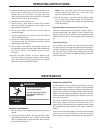
-12-
TROUBLESHOOTING GUIDE
Observe all Safety Guidelines detailed throughout this manual
If for any reason you do not understand the test procedures or are unable to perform the tests/repairs safely, contact the Lincoln Electric
Service Department for technical troubleshooting assistance before you proceed. Call 216-383-2531 or 1-800-833-9353.
CAUTION
PROBLEMS
(SYMPTOMS)
POSSIBLE CAUSE REMEDY
Input contactor (CR1) chatters.
Machine input contactor does not operate.
Machine input contactor operates but no output
when trying to weld.
Machine has maximum output but no control.
Machine does not have maximum output.
Machine has output but trips off immediately.
a. Faulty input contactor (1CR).
b. Low line voltage.
c. Faulty pilot relay (2CR).
a. Supply line fuse blown.
b. Contactor power circuit dead.
c. Broken power lead.
d. Wrong input voltage.
e. Primary or power SCR thermostats open.
f. Open input contactor coil.
g. Faulty on-off switch.
h. Faulty pilot relay (2CR).
a. Electrode or work lead loose or broken.
b. Open main transformer (T5) primary or sec-
ondary circuit.
c. “Firing Circuit” P.C. board not connected or is
faulty.
d. Output pilot relay (6CR) not operating or faulty.
a. “Output Control” switch (SW4) in wrong position.
b. “Output Control” switch faulty.
c. Open in feed back circuitry.
d. Faulty “Control/Fault Protection” or “Firing Circuit”
P.C. boards.
e. Output control potentiometer open (lead no. 75).
a. One input fuse blown.
b. One phase of main transformer open.
c. Faulty “Control/Fault Protection” or “Firing Circuit”
P.C. boards.
d. Output control potentiometer defective.
e. Output control potentiometer leads open 226,
237, 236, 73, 74, 76, 77.
a. Machine has either an internal or external short
circuit on the output.
b. Faulty “Control/Fault Protection” P.C. board.
c. Machine output voltage applied to control leads.
a. Repair or replace.
b. Check with power company.
c. Replace relay.
a. Replace if blown. Look for reason first.
b. Check pilot transformer T1 and associated leads
and 5 amp fuse.
c. Check input voltage at contactor.
d. Check voltage against nameplate.
e. Check for overheating. Make sure both fans are
operating and there is no obstruction to free air flow.
Faulty thermostats — replace.
f. Replace coil.
g. Replace switch.
h. Replace relay.
a. Repair connection.
b. Repair.
c. All nine light emitting diodes (L1 thru L9) must be
lit. (See “P.C. Board Troubleshooting Guide”.)
d. Check relay by connecting a jumper across termi-
nals 2 and 4 on DC-1500 terminal strip. Replace if
faulty.
a. Check position of switch.
b. Check switch and replace if faulty.
c. Check wiring and control and “Firing Circuit” P.C.
board wiring harness plugs.
d. All light emitting diodes must be lit, except L4 on
“Control/Fault Protection” board. (See “P.C. Board
Troubleshooting Guide.”)
e. Check and replace if faulty.
a. Check and replace if blown after checking for rea-
son for blown fuse.
b. Check for open and repair.
c. All light emitting diodes must be lit on both P.C.
boards, except L4 on “Control/Fault Protection”
board. (See “P.C. Board Troubleshooting Guide.”)
d. Check and replace if faulty.
e. Check and repair broken leads.
a. Check internally and externally for any shorts and
remove or repair.
b. If no short circuits, LED L4 must be lit (See “P.C.
Board Troubleshooting Guide”).
c. Check control cable or wire feeder for shorted or
grounded control leads.
Note: To locate the “Firing Circuit” and “Control/Fault
Protection Circuit” P.C. boards, remove the upper
case panel on the left side of the machine. The
names are printed on the boards.
ELECTRIC SHOCK can kill.
• Have a qualified individual install
and service this equipment.
• Turn the input supply power OFF
at the disconnect switch or fuse
box before working on this equip-
ment.
• Do not touch electrically hot parts.
------------------------------------------------------------------------
WARNING


















